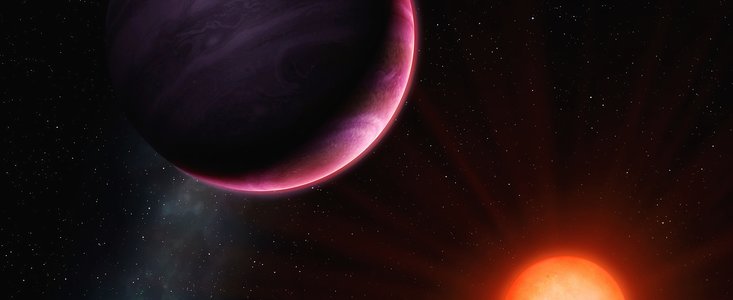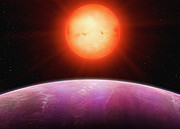Annuncio
Lo strumento NGTS trova il suo primo esopianeta
31 Ottobre 2017
Lo strumento Next Generation Transit Survey (NGTS), installato presso l’Osservatorio dell’ESO al Paranal, nel Nord del Cile, ha scoperto il suo primo esopianeta, un gioviano caldo in orbita intorno a una stella nana di tipo M [1], ora chiamata NGTS-1. Il pianeta NGTS-1b è soltanto il terzo gigante gassoso ad essere stato osservato mentre transita intorno a una stella nana di tipo M, dopo Kepler-45b e HATS-6b. NGTS-1b è il più grande e massiccio dei tre, con un raggio e una massa pari, rispettivamente, a 1,3 e 0,8 volte quelli di Giove.
Lo strumento NGTS è una schiera di dodici telescopi da 20 cm progettati per rilevare i lievi cali di luminosità delle stelle che si originano quando un pianeta in orbita vi passa (o "transita") davanti, bloccando parte della loro luce. La scoperta di NGTS-1b è stata poi confermata da osservazioni di follow-up presso l’Osservatorio dell’ESO a La Silla: osservazioni fotometriche con lo strumento EulerCam, montato sul telescopio svizzero da 1,2 metri Leonhard Euler, e osservazioni spettroscopiche con lo strumento HARPS, montato sul telescopio da 3,6 metri dell’ESO.
Mentre pianeti di piccole dimensioni sono relativamente comuni intorno a stelle nane di tipo M, la presenza intorno a esse di giganti gassosi come NGTS-1b sembra essere molto più rara di quanto non avvenga intorno a stelle più simili al Sole. Ciò è coerente con le attuali teorie di formazione planetaria, ma sarà comunque necessario osservare un maggior numero di nane di tipo M per arrivare a stabilire quanti siano effettivamente i giganti gassosi che vi orbitano intorno. Lo strumento NGTS è stato progettato appositamente per fornire dati migliori sui pianeti in orbita intorno a stelle nane e, dato che queste rappresentano circa il 75% delle stelle presenti nella Via Lattea, studiarle significa anche aiutare gli astronomi a capire quella che è la popolazione principale di pianeti della nostra galassia.
In futuro ci potrebbero essere novità interessanti su questo sistema di esopianeti, dato che potrebbe essere studiato nel dettaglio dalla serie di strumenti a bordo del James Webb Space Telescope (JWST) della NASA/ESA/CSA, il cui lancio è previsto per il 2019.
Note
[1] Le stele nane di tipo M sono deboli stelle con massa compresa tra l’8% e il 50% di quella del Sole e una temperatura superficiale inferiore a 3700°. Fra le 60 stelle più vicine al nostro Sistema Solare, si stima che le nane di tipo M siano 50, ma nemmeno una di esse è abbastanza luminosa da essere visibile a occhio nudo dalla Terra.
Ulteriori Informazioni
Questa ricerca sarà pubblicata nell’articolo: “NGTS-1b: A hot Jupiter transiting an M-dwarf”, di D. Bayliss et al., in uscita sulla rivista Monthly Notices of the Royal Astronomical Society.
Il team è compost da: D. Bayliss (Università di Ginevra, Svizzera), E. Gillen (Università di Cambridge, Regno Unito), P. Eigmüller (DLR, Germania), J. McCormac (Università di Warwick, Regno Unito), R. Alexander (Università di Leicester, Regno Unito), D. Armstrong (Università di Warwick, Regno Unito), R. Booth (Queen's University Belfast, Regno Unito), F. Bouchy (Università di Ginevra, Svizzera), M. Burleigh, J. Cabrera (DLR, Germania), S. Casewell, A. Chaushev (Università di Leicester, Regno Unito), B. Chazelas, S. Csizmadia, A. Erikson, F. Faedi (Università di Warwick, Regno Unito), E. Foxwell (Università di Warwick, Regno Unito), B. Gaensicke (Università di Warwick, Regno Unito), M. Goad (Università di Leicester, Regno Unito), A. Grange, M. Guenther (Università di Cambridge, Regno Unito), S. Hodgkin (Università di Cambridge, Regno Unito), J. Jackman, J. Jenkins (Università del Cile, Cile), G. Lambert (Università di Cambridge), T. Louden (Università di Warwick, Regno Unito), L. Metrailler (Università di Ginevra, Svizzera), M. Moyano (Università Cattolica del Nord, Cile), D. Pollacco (Università di Warwick, Regno Unito), K. Poppenhaeger, (Queen's University Belfast, Regno Unito; Harvard-Smithsonian Center for Astrophysics, Stati Uniti), D. Queloz (Università di Ginevra, Svizzera), R. Raddi (Università di Warwick, Regno Unito), H. Rauer (DLR, Germania), L. Raynard (Università di Leicester, Regno Unito), A. Smith, M. Soto (Università del Cile, Cile), A. Thompson (Queen’s University Belfast, Regno Unito), R. Titz-Weider (DLR, Germania), S. Udry (Università di Ginevra, Svizzera), S. Walker (Università di Warwick, Regno Unito), C. Watson (Queen's University Belfast, Regno Unito), R. West (Università di Warwick, Regno Unito) e P.J. Wheatley (Università di Warwick, Regno Unito).
Links
- Articolo scientifico 1: The Next Generation Transit Survey (NGTS)
- Articolo scientifico 2: NGTS-1b: A hot Jupiter transiting an M-dwarf
Contatti
Daniel Bayliss
Department of Physics
University of Warwick
, UK
Tel: +44 (0) 24761 50342
Cell: +44 (0) 7514912757
Email: d.bayliss@warwick.ac.uk
Richard Hook
ESO Public Information Officer
Garching bei München, Germany
Tel: +49 89 3200 6655
Cell: +49 151 1537 3591
Email: rhook@eso.org
A proposito dell'annuncio
| Identificazione: | ann17076 |
Our use of Cookies
We use cookies that are essential for accessing our websites and using our services. We also use cookies to analyse, measure and improve our websites’ performance, to enable content sharing via social media and to display media content hosted on third-party platforms.
ESO Cookies Policy
The European Organisation for Astronomical Research in the Southern Hemisphere (ESO) is the pre-eminent intergovernmental science and technology organisation in astronomy. It carries out an ambitious programme focused on the design, construction and operation of powerful ground-based observing facilities for astronomy.
This Cookies Policy is intended to provide clarity by outlining the cookies used on the ESO public websites, their functions, the options you have for controlling them, and the ways you can contact us for additional details.
What are cookies?
Cookies are small pieces of data stored on your device by websites you visit. They serve various purposes, such as remembering login credentials and preferences and enhance your browsing experience.
Categories of cookies we use
Essential cookies (always active): These cookies are strictly necessary for the proper functioning of our website. Without these cookies, the website cannot operate correctly, and certain services, such as logging in or accessing secure areas, may not be available; because they are essential for the website’s operation, they cannot be disabled.
Functional Cookies: These cookies enhance your browsing experience by enabling additional features and personalization, such as remembering your preferences and settings. While not strictly necessary for the website to function, they improve usability and convenience; these cookies are only placed if you provide your consent.
Analytics cookies: These cookies collect information about how visitors interact with our website, such as which pages are visited most often and how users navigate the site. This data helps us improve website performance, optimize content, and enhance the user experience; these cookies are only placed if you provide your consent. We use the following analytics cookies.
Matomo Cookies:
This website uses Matomo (formerly Piwik), an open source software which enables the statistical analysis of website visits. Matomo uses cookies (text files) which are saved on your computer and which allow us to analyze how you use our website. The website user information generated by the cookies will only be saved on the servers of our IT Department. We use this information to analyze www.eso.org visits and to prepare reports on website activities. These data will not be disclosed to third parties.
On behalf of ESO, Matomo will use this information for the purpose of evaluating your use of the website, compiling reports on website activity and providing other services relating to website activity and internet usage.
Matomo cookies settings:
Additional Third-party cookies on ESO websites: some of our pages display content from external providers, e.g. YouTube.
Such third-party services are outside of ESO control and may, at any time, change their terms of service, use of cookies, etc.
YouTube: Some videos on the ESO website are embedded from ESO’s official YouTube channel. We have enabled YouTube’s privacy-enhanced mode, meaning that no cookies are set unless the user actively clicks on the video to play it. Additionally, in this mode, YouTube does not store any personally identifiable cookie data for embedded video playbacks. For more details, please refer to YouTube’s embedding videos information page.
Cookies can also be classified based on the following elements.
Regarding the domain, there are:
- First-party cookies, set by the website you are currently visiting. They are stored by the same domain that you are browsing and are used to enhance your experience on that site;
- Third-party cookies, set by a domain other than the one you are currently visiting.
As for their duration, cookies can be:
- Browser-session cookies, which are deleted when the user closes the browser;
- Stored cookies, which stay on the user's device for a predetermined period of time.
How to manage cookies
Cookie settings: You can modify your cookie choices for the ESO webpages at any time by clicking on the link Cookie settings at the bottom of any page.
In your browser: If you wish to delete cookies or instruct your browser to delete or block cookies by default, please visit the help pages of your browser:
Please be aware that if you delete or decline cookies, certain functionalities of our website may be not be available and your browsing experience may be affected.
You can set most browsers to prevent any cookies being placed on your device, but you may then have to manually adjust some preferences every time you visit a site/page. And some services and functionalities may not work properly at all (e.g. profile logging-in, shop check out).
Updates to the ESO Cookies Policy
The ESO Cookies Policy may be subject to future updates, which will be made available on this page.
Additional information
For any queries related to cookies, please contact: pdprATesoDOTorg.
As ESO public webpages are managed by our Department of Communication, your questions will be dealt with the support of the said Department.


